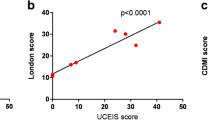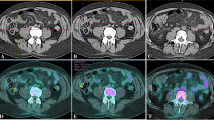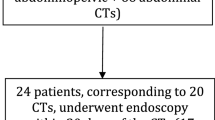Abstract.
Objective:
This prospective study evaluated a 99mTc antigranulocyte monoclonal antibody Fab' imaging agent (Sulesomab) in children with inflammatory bowel disease (IBD) newly diagnosed by colonoscopy.
Materials and methods:
Ten children (4 boys, 6 girls; mean age 14 years) with newly diagnosed Crohn's disease (n = 6) or ulcerative colitis (n = 4) were studied. Colonoscopy was performed in all of these patients. Within 24 h after colonoscopy, they underwent scintigraphy with 99 mTc-Sulesomab. Abdominal/pelvic images were acquired at 30 min (planar) and 2–4 h (planar and SPECT) after injection of Sulesomab. Eighty bowel segments were evaluated semi-quantitatively by the investigators, using these three sets of images. The Pediatric Disease Activity (PDA) was correlated with the erythrocyte sedimentation rate (ESR), white blood cell (WBC) count, albumin, Kirschner's score, the Sulesomab bowel segment with maximum uptake, and the sum of Sulesomab score in each segment.
Results:
The median PDA score was 26 (range 12.5–40). Three children had normal ESR and six normal WBC counts. All patients had at least one positive mucosal biopsy for IBD. While using the Kirschner's scale, the maximal severity of colonoscopy findings was graded as none (n = 2), mild (n = 4), moderate (n = 3), or severe (n = 1). Of the 59 segments evaluated with endoscopy, 35 were found to be endoscopically abnormal. The planar images identified 17 of these abnormal segments and the SPECT images 20. Nine of these ten children had abnormal bowel uptake by scintigraphy. Thus, the sensitivity of Sulesomab per patient was 90 % and per bowel segment 57 %. The correlation coefficient between the scintigraphic score for the segment with the Sulesomab maximum activity and the PDA was 0.3 (P = 0.41).
Conclusion:
In pediatric IBD assessment, planar imaging with Sulesomab did not prove very sensitive in detecting inflammation in each bowel segment. However, SPECT detected the presence of inflammation in the majority of patients. A trial comparing 99 mTc-HmPAO-WBC with Sulesomab in a large number of patients is required.
Similar content being viewed by others
Author information
Authors and Affiliations
Additional information
Received: 23 January 2001 Accepted: 14 May 2001
Rights and permissions
About this article
Cite this article
Charron, M., Di Lorenzo, C., Kocoshis, S. et al. 99 mTc antigranulocyte monoclonal antibody imaging for the detection and assessment of inflammatory bowel disease newly diagnosed by colonoscopy in children. Pediatric Radiology 31, 796–800 (2001). https://doi.org/10.1007/s002470100537
Issue Date:
DOI: https://doi.org/10.1007/s002470100537




